seat adjustment PEUGEOT 2008 2013.5 Owners Manual
[x] Cancel search | Manufacturer: PEUGEOT, Model Year: 2013.5, Model line: 2008, Model: PEUGEOT 2008 2013.5Pages: 336, PDF Size: 9.23 MB
Page 4 of 336
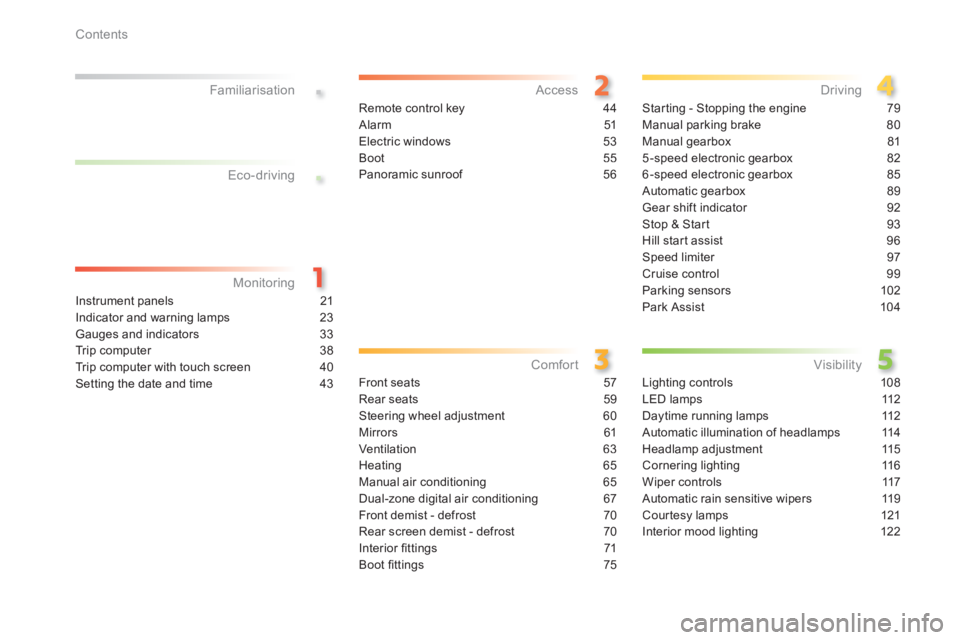
.
.
Contents
Instrument panels 21
Indicator and warning lamps 23
Gauges and indicators 33
Trip computer 38
Trip computer with touch screen 40
Setting the date and time 43
Monitoring
Familiarisation
Remote control key
44
Alarm 51
Electric windows 53
Boot 55
Panoramic sunroof 56
Access
Front seats 57
Rear seats 59
Steering wheel adjustment 60
Mirrors 61
Ventilation 63
Heating 65
Manual air conditioning 65
Dual-zone digital air conditioning 67
Front demist - defrost 70
Rear screen demist - defrost 70
Interior fi ttings 71
Boot fi ttings 75
Comfort
Starting - Stopping the engine 79
Manual parking brake 80
Manual gearbox 81
5-speed electronic gearbox 82
6-speed electronic gearbox 85
Automatic gearbox 89
Gear shift indicator 92
Stop & Start 93
Hill start assist 96
Speed limiter 97
Cruise control 99
Parking sensors 102
Park Assist 104
Driving
Lighting controls 108
LED lamps 112
Daytime running lamps 112
Automatic illumination of headlamps 114
Headlamp adjustment 115
Cornering lighting 116
Wiper controls 117
Automatic rain sensitive wipers 119
Courtesy lamps 121
Interior mood lighting 122
Visibility
Eco-driving
Page 12 of 336
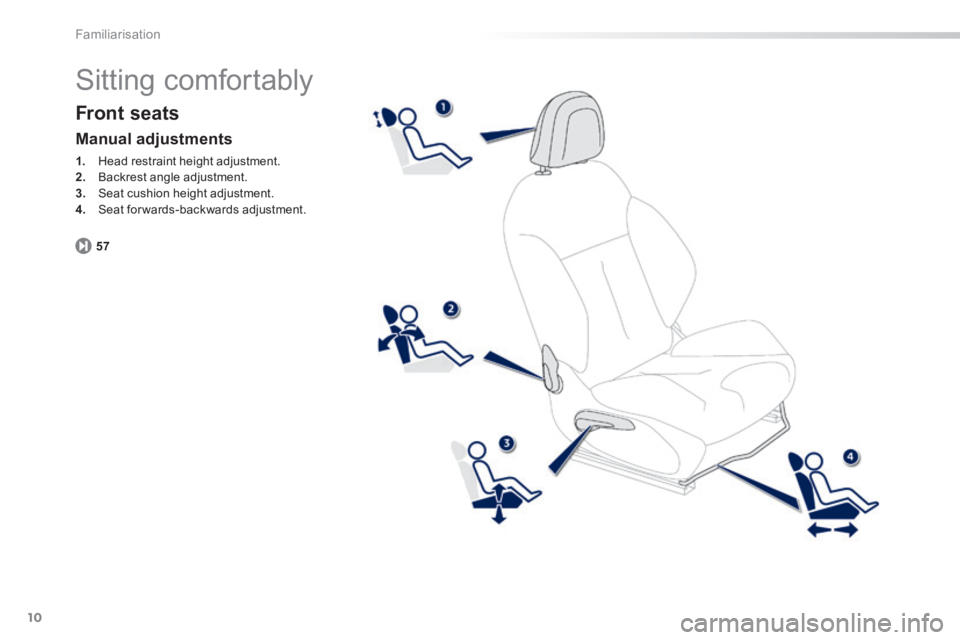
10
57
Familiarisation
Sitting comfortably
Front seats
Manual adjustments
1. Head restraint height adjustment. 2. Backrest angle adjustment. 3. Seat cushion height adjustment. 4. Seat forwards-backwards adjustment.
Page 13 of 336
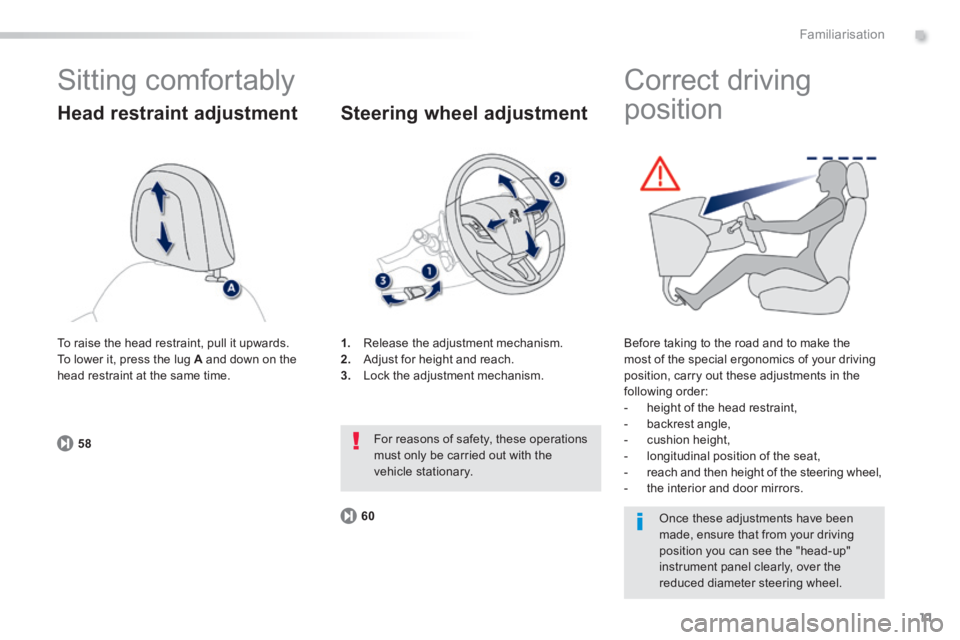
.
11
5860
Familiarisation
Sitting comfortably
Head restraint adjustment
1. Release the adjustment mechanism. 2. Adjust for height and reach. 3. Lock the adjustment mechanism.
Steering wheel adjustment
For reasons of safety, these operations must only be carried out with the vehicle stationary.
To raise the head restraint, pull it upwards. To lower it, press the lug A and down on the head restraint at the same time.
Correct driving
position
Before taking to the road and to make the most of the special ergonomics of your driving position, carry out these adjustments in the following order: - height of the head restraint, - backrest angle, - cushion height, - longitudinal position of the seat, - reach and then height of the steering wheel, - the interior and door mirrors.
Once these adjustments have been made, ensure that from your driving position you can see the "head-up" instrument panel clearly, over the reduced diameter steering wheel.
Page 14 of 336
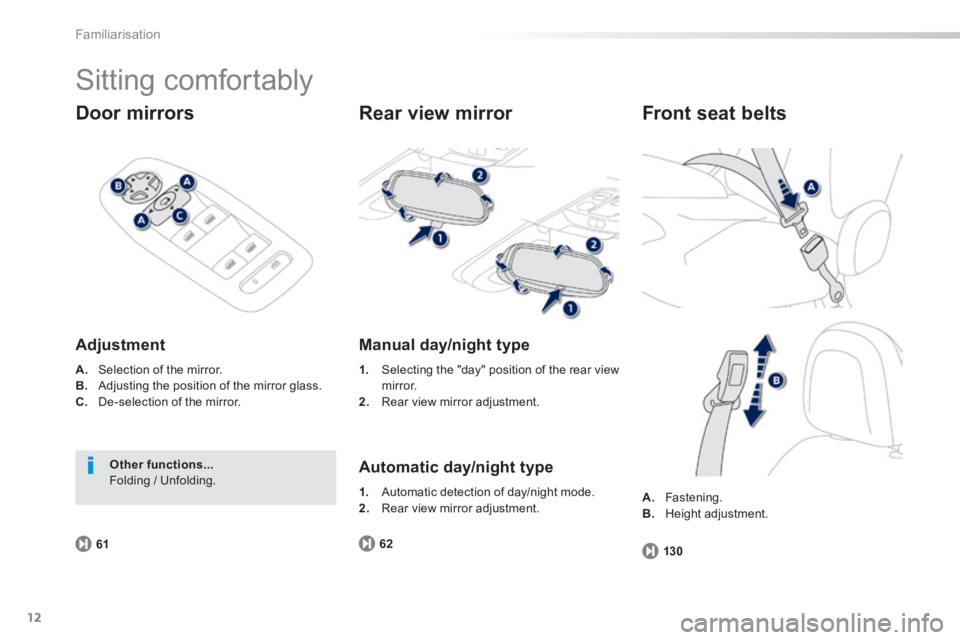
12
6162
130
Familiarisation
Sitting comfortably
Door mirrors
Adjustment
A. Selection of the mirror. B. Adjusting the position of the mirror glass. C. De-selection of the mirror.
Other functions... Folding / Unfolding.
Rear view mirror
Manual day/night type
1. Selecting the "day" position of the rear view m i r r o r. 2. Rear view mirror adjustment.
Automatic day/night type
1. Automatic detection of day/night mode. 2. Rear view mirror adjustment. A. Fastening. B. Height adjustment.
Front seat belts
Page 59 of 336
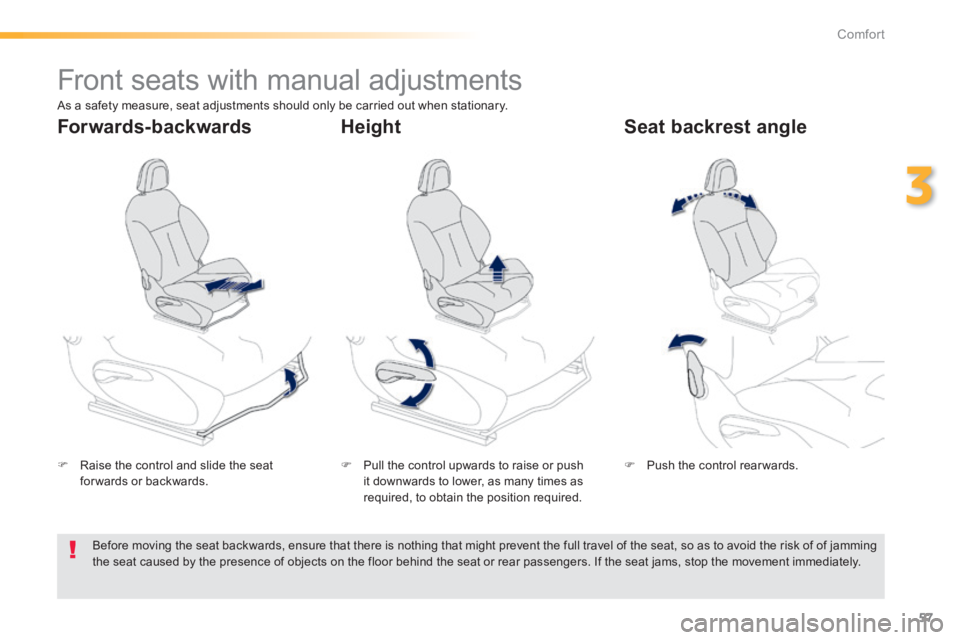
57
3
Comfort
Front seats with manual adjustments
Raise the control and slide the seat for wards or backwards. Pull the control upwards to raise or push it downwards to lower, as many times as required, to obtain the position required.
Push the control rear wards.
Forwards-backwards Height Seat backrest angle
As a safety measure, seat adjustments should only be carried out when stationary.
Before moving the seat backwards, ensure that there is nothing that might prevent the full travel of the seat, so as to avoid the risk of of jamming the seat caused by the presence of objects on the floor behind the seat or rear passengers. If the seat jams, stop the movement immediately.
Page 60 of 336
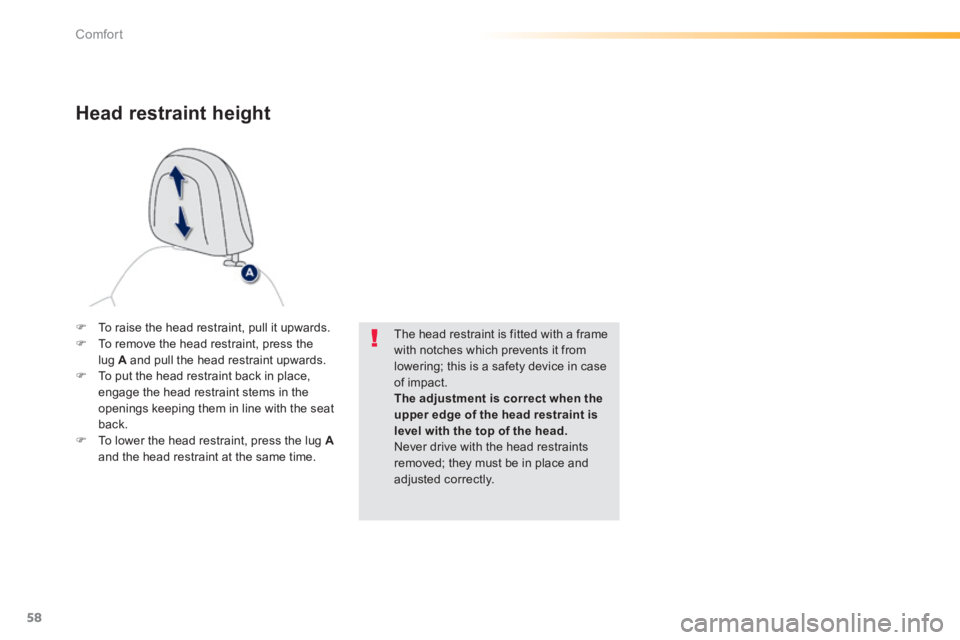
58
Comfort
To raise the head restraint, pull it upwards. To remove the head restraint, press the lug A and pull the head restraint upwards. To put the head restraint back in place, engage the head restraint stems in the openings keeping them in line with the seat back.
To lower the head restraint, press the lug Aand the head restraint at the same time.
The head restraint is fitted with a frame with notches which prevents it from lowering; this is a safety device in case of impact. The adjustment is correct when the upper edge of the head restraint is
level with the top of the head. Never drive with the head restraints removed; they must be in place and adjusted correctly.
Head restraint height
Page 117 of 336
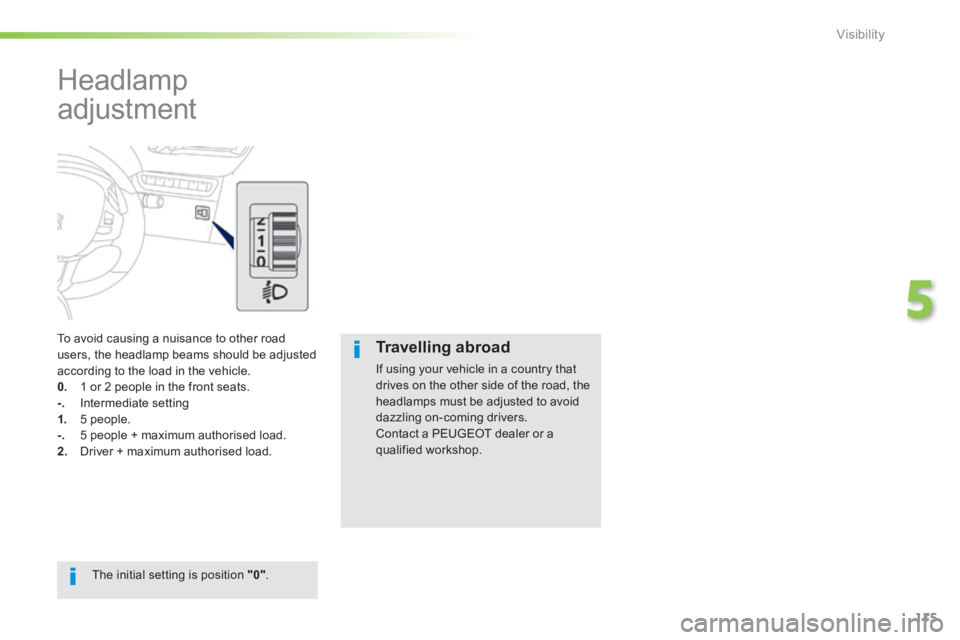
115
5
Visibility
Headlamp
adjustment
To avoid causing a nuisance to other road users, the headlamp beams should be adjusted according to the load in the vehicle. 0. 1 or 2 people in the front seats. - . Intermediate setting 1. 5 people. -. 5 people + maximum authorised load. 2. Driver + maximum authorised load.
The initial setting is position "0" .
Travelling abroad
If using your vehicle in a country that drives on the other side of the road, the headlamps must be adjusted to avoid dazzling on-coming drivers. Contact a PEUGEOT dealer or a qualified workshop.
Page 132 of 336
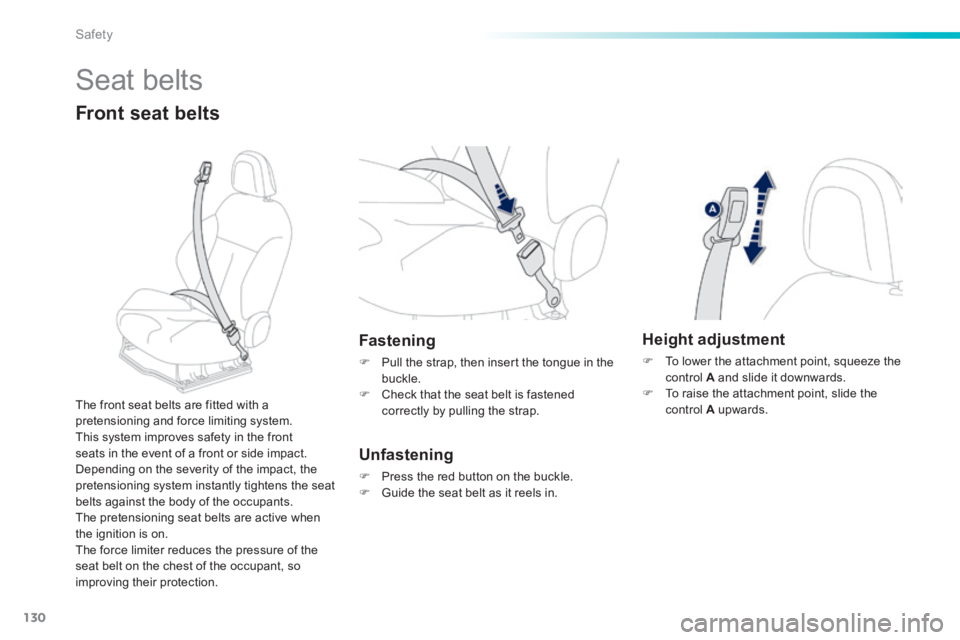
130
Safety
Seat belts
Front seat belts
Fastening
Pull the strap, then insert the tongue in the buckle. Check that the seat belt is fastened correctly by pulling the strap.
Unfastening
Press the red button on the buckle. Guide the seat belt as it reels in.
The front seat belts are fitted with a pretensioning and force limiting system. This system improves safety in the front seats in the event of a front or side impact. Depending on the severity of the impact, the pretensioning system instantly tightens the seat belts against the body of the occupants. The pretensioning seat belts are active when the ignition is on. The force limiter reduces the pressure of the seat belt on the chest of the occupant, so improving their protection.
Height adjustment
To lower the attachment point, squeeze the control A and slide it downwards. To raise the attachment point, slide the control A upwards.
Page 134 of 336
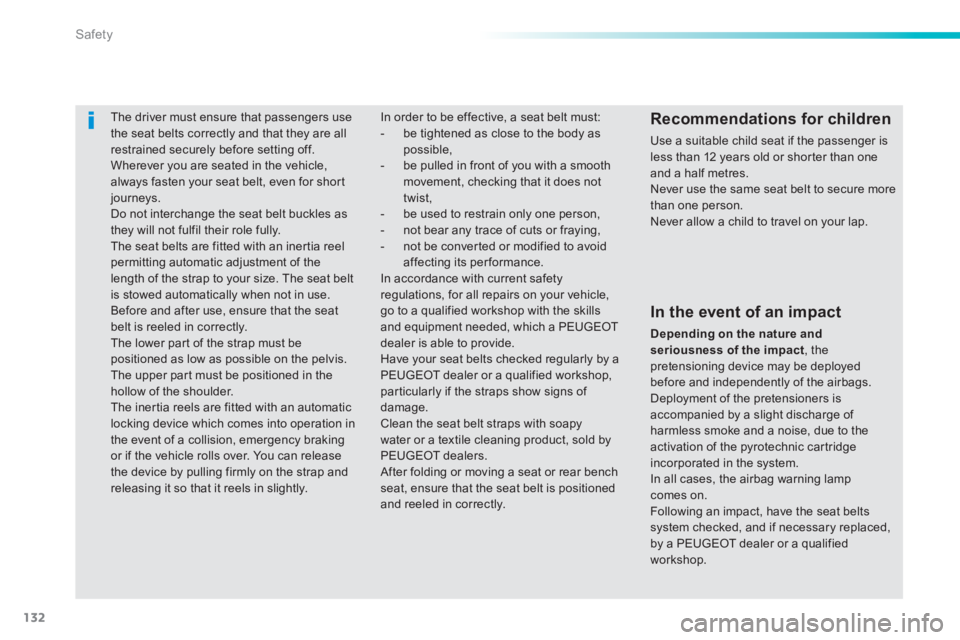
132
Safety
The driver must ensure that passengers use the seat belts correctly and that they are all restrained securely before setting off. Wherever you are seated in the vehicle, always fasten your seat belt, even for short journeys. Do not interchange the seat belt buckles as they will not fulfil their role fully. The seat belts are fitted with an inertia reel permitting automatic adjustment of the length of the strap to your size. The seat belt is stowed automatically when not in use. Before and after use, ensure that the seat belt is reeled in correctly. The lower part of the strap must be positioned as low as possible on the pelvis. The upper part must be positioned in the hollow of the shoulder. The inertia reels are fitted with an automatic locking device which comes into operation in the event of a collision, emergency braking or if the vehicle rolls over. You can release the device by pulling firmly on the strap and releasing it so that it reels in slightly.
Recommendations for children
Use a suitable child seat if the passenger is less than 12 years old or shorter than one and a half metres. Never use the same seat belt to secure more than one person. Never allow a child to travel on your lap.
In order to be effective, a seat belt must: - be tightened as close to the body as possible, - be pulled in front of you with a smooth movement, checking that it does not twist, - be used to restrain only one person, - not bear any trace of cuts or fraying, - not be converted or modified to avoid affecting its performance. In accordance with current safety regulations, for all repairs on your vehicle, go to a qualified workshop with the skills and equipment needed, which a PEUGEOT dealer is able to provide. Have your seat belts checked regularly by a PEUGEOT dealer or a qualified workshop, particularly if the straps show signs of damage. Clean the seat belt straps with soapy water or a textile cleaning product, sold by PEUGEOT dealers. After folding or moving a seat or rear bench seat, ensure that the seat belt is positioned and reeled in correctly.
In the event of an impact
Depending on the nature and seriousness of the impact , the pretensioning device may be deployed before and independently of the airbags. Deployment of the pretensioners is accompanied by a slight discharge of harmless smoke and a noise, due to the activation of the pyrotechnic cartridge incorporated in the system. In all cases, the airbag warning lamp comes on. Following an impact, have the seat belts system checked, and if necessary replaced,
by a PEUGEOT dealer or a qualified
workshop.
Page 145 of 336
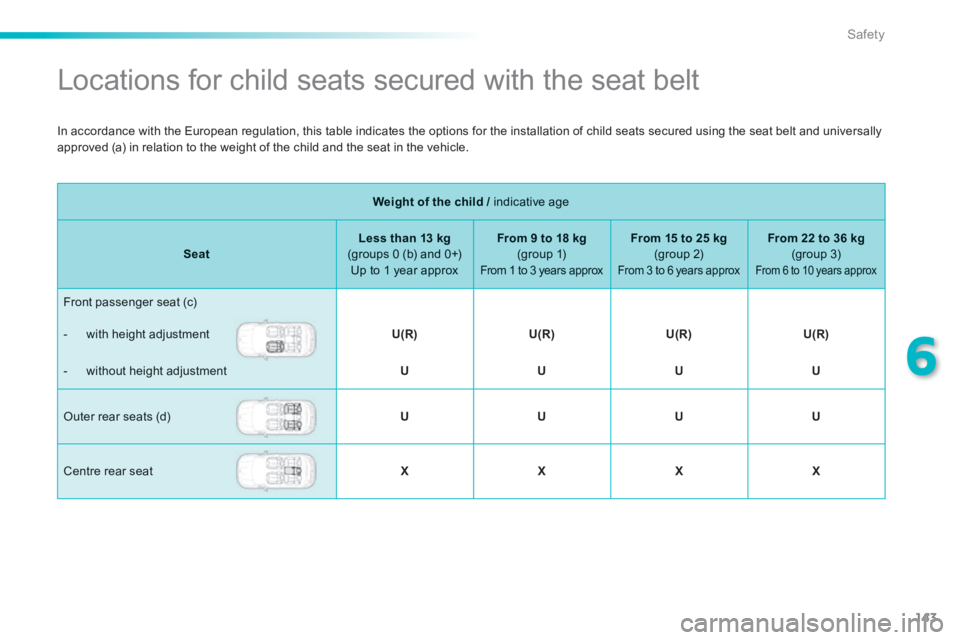
143
6
Safety
Locations for child seats secured with the seat belt
Weight of the child / indicative age Weight of the child / indicative age Weight of the child /
SeatLess than 13 kg (groups 0 (b) and 0+) Up to 1 year approx
From 9 to 18 kg (group 1) From 1 to 3 years approx
From 15 to 25 kg (group 2) From 3 to 6 years approx
From 22 to 36 kg (group 3) From 6 to 10 years approx
Front passenger seat (c)
- with height adjustment U(R)U(R)U(R)U(R)
- without height adjustment UUUU
Outer rear seats (d) UUUU
Centre rear seat XXXX
In accordance with the European regulation, this table indicates the options for the installation of child seats secured using the seat belt and universally approved (a) in relation to the weight of the child and the seat in the vehicle.